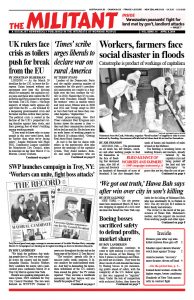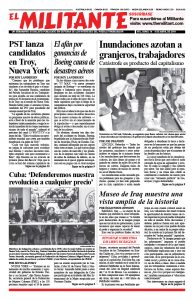More information continues to come to light making it crystal clear that the crashes of two Boeing 737 Max 8 planes in Indonesia and Ethiopia were not accidents. They were the direct result of cold-blooded decisions by Boeing bosses to put maximizing profits ahead of safety, with the complicity of the U.S. federal agency that was supposed to “regulate” them. Under the lash of competition with archrival Airbus, they drove the planes into production with calculated disregard for the threat to human lives.
Boeing bosses are hoping they can make quick software and other changes to get the worldwide grounding of the planes lifted and keep airlines from switching orders to Airbus.
A March 23 article in the New York Times notes that in 2011, Boeing bosses were planning an entirely new mid-size plane. But they learned that American Airlines, “an exclusive Boeing customer for more than a decade,” was on the verge of ordering hundreds of new, fuel-efficient jets from Airbus. Billions of dollars in sales were at stake.
So Boeing’s bosses pulled out all the stops, deciding to update the company’s top-selling 737 instead. This meant the 737 Max 8 could be ready in a record six years.
“Engineers were pushed to submit technical drawings and designs at roughly double the normal pace,” the Times reports. Bosses told them, “Limit changes to hopefully avert a requirement that pilots spend time training in a flight simulator before flying the Max 8.”
To win out over Airbus, Boeing told customers that pilots wouldn’t need expensive new simulator training because, they claimed, flying the 737 Max 8 was essentially the same as the old model.
Minimizing or avoiding extra training is a key selling point in the eyes of the commercial airline bosses, who don’t want to cut into their profits. Boeing’s strategy succeeded and the company got orders for thousands of planes.
To increase fuel efficiency and range enough to compete with the Airbus A320neo, the Max 8 was fitted with larger, more fuel-efficient engines. The new configuration gave the plane a tendency to nose up too high under certain conditions, which could cause a stall.
Their hurried solution was to design automated software, activated by a sensor, which would take over control and force the nose down. This sensor apparently malfunctioned in both crashes. Post-crash simulator tests March 23 showed that pilots only have 40 seconds to override the automatic system to avert disaster.
Boeing could have connected an additional sensor to a warning light flashing at any problem, but to get this, you had to pay more. Neither the Ethiopian nor Indonesian planes had this feature.
This system and others were never inspected by the Federal Aviation Administration, which allowed Boeing to use its own engineers to certify that their work on the Max 8 was safe.
Flight crews were not told about, much less trained on, the new software. On old 737s a tug on the yoke turned off the autopilot. They were never told that this wouldn’t work on the Max 8.
Boeing bosses made a cold-blooded judgment that risks of a crash weighed less than their profits. Over Boeing’s initial objections, the plane was grounded by governments worldwide.
Boeing now plans to install one of the “optional” safety features in 737 MAXs as standard equipment and is readying a software upgrade to prevent any recurrence. Bosses hope they will secure the FAA safety certification within weeks.
Meanwhile, their planes sit on the ground. The airline bosses who bought the Boeing planes are facing disruptions to service — and to profits. There are threats by some airlines to cancel orders and Boeing stock is in free fall.
To guarantee safety and lives of passengers and airline workers, the unions need to fight for workers control of production and safety in the air. Pilots should have the power to say, “Stop! This plane’s not flying if it’s not safe.”

